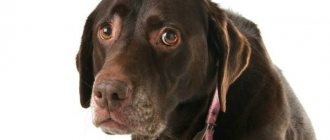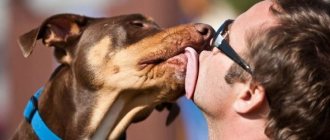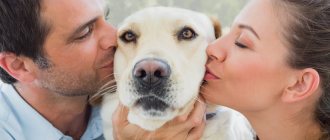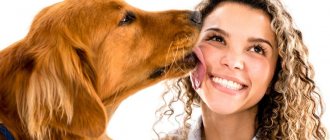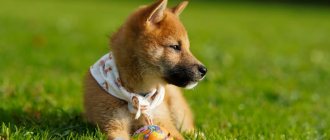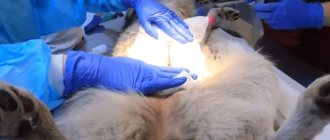Sometimes misunderstandings occur in the relationship between a person and an animal: for some reason a dog growls at its owner.
What to do, how to wean a pet that has suddenly become aggressive, refuses to bathe, does not allow you to take a toy or approach the food bowl? A sudden change in a dog’s mood and behavior must have serious reasons. But the owner is not always able to resolve the conflict on his own and feels helpless. Let's take a closer look at the causes of the problem and find options to solve it.
What is the reason for this behavior?
A dog can not only growl, but also demonstrate his negative attitude in other ways - bare his teeth, bark, or not complete the task given to him. An angry animal may be overly protective of its bowl, toys, or other objects that the pet considers to be its own.
In addition, the dog can show excessive dissatisfaction during hygiene procedures that it especially does not like, for example, when trimming its nails, combing its fur, or using a trimmer.
But sometimes such behavior is not a sign of aggression, it signals that the pet is confused and feels defenseless. How can you find out the cause of the growling?
Experts identify several situations that can provoke growling, anxiety and other emotions in a dog:
- The dog considers himself the master of the house . Representatives of many breeds have a tendency to dominate, which they often display when communicating with family members and other pets. Often it is the spoiled individuals who become leaders, as the owner makes the mistake of trying in every possible way to please his four-legged friend. The animal begins to be jealous of its things - food, toys, not allowing the owner to approach and take them. In addition, the dog can also encroach on objects that do not belong to him. With a growl, he declares his rights and confirms that there is only one owner in the house!
- The dog responds to cruelty with aggression . In this case, the situation is the opposite - the pet is constantly faced with cruelty directed at it, and the growling becomes a warning signal - not to approach. A dog may also growl when it is being punished or scolded for misbehavior or for no reason.
- By growling, the dog shows a sense of ownership . This behavior is typical of teenage males, who not only grow and become stronger, but also try to assert themselves. During this period, many owners are faced with the fact that an obedient and flexible dog suddenly becomes uncontrollable. This happens due to natural instincts - the animal shows its leadership qualities, and the goal of such behavior is one - to become a leader. In addition to growling, the dog can violate previously established boundaries, occupying forbidden territory. Most often, it serves as the owner’s sleeping place. At the same time, we are not talking about any fear; with all his appearance, the male shows his fearlessness and confirms his importance.
- Food aggression . In this situation, the puppy may snatch the treat, biting his hand, or growl when the owner pets him while eating. An adult dog may grin or freeze while eating food if the owner comes too close or reaches out to the bowl. This behavior can be corrected; there are several methods for this.
- Aggression of a puppy bitch . A mother always tries to protect her offspring - this is a strong innate instinct that helps bitches ensure the safety of their babies. During this period, she can show anger towards other bitches, even for no apparent reason. And keep the owner away from the puppies at home, but most often this only applies to children.
- Reaction to pain . Dogs, especially those that are overly independent and active, are often injured, receiving external or internal injuries. Sometimes the owners don’t even know about it, or the dog has no visible wounds. Naturally, when touched, the pet may growl, move away, and whine.
In almost all of these situations, except for the dominant manifestation, there is an irritant that provokes the dog. But the most difficult thing to correct is the errors of upbringing, in which the dog allows itself to behave inappropriately towards the owner.
How to deal with dominant behavior in dogs
Before you begin to correct your dog’s behavior, you should really assess your capabilities. Maybe you shouldn’t enter into a conflict, but it’s better to entrust the re-education to a dog handler? In order for the owner to dominate the house, and the dog to become obedient and flexible, it is worth starting with the following methods of influence:
- Feeding. Stop feeding your pet before you have breakfast yourself, or before you leave the table. Train your dog to start eating only on command and to give away leftover food without aggression. “Don’t be fooled” by his growl. Back off at least once - the dog will understand that growling can get its way. If the dog has a habit of begging or hanging around the table, do not react to such behavior.
- Weasel. Even a very sweet and beautiful dog cannot be loved and cared for too much, or shown your devotion to it. You should not constantly stroke or caress your pet. This behavior confuses the understanding of hierarchy. The dog imagines itself to be in charge. Affection must be dosed and shown as a reward for obedience and good behavior. Show moderation!
During the training process, you should never show your pets your fear. They feel it perfectly. Remember this from the first days the puppy is in your home. But by and large, he needs to be accustomed to commands immediately after he gets used to his new home. Training and following commands are essential conditions for the owner's dominance. We must strive for their unquestioning implementation always and everywhere. Like other behavioral problems, dominant behavior in a pet is easier to prevent than to correct.
Causes of aggression
There are 4 fundamental reasons why an animal can show aggression and growl at the owner.
- This list includes animal breeding that was poorly planned, in other words, not thought out at all.
- Also, a dog can grumble due to improper upbringing, aggression towards it, violence from a person, constant bullying (intentional provocation of evil).
- Another reason is the intrusiveness of children or guests (friends of the owner). A man's friend simply cannot calm down, because she is disturbed day and night. This is where aggressive signs and growling arise.
- It is necessary to highlight incorrectly carried out or late socialization, due to which the pet cannot adequately respond to other animals or people.
It is important to understand that aggression, as well as attachment, refers to the emotions of an animal. It is forbidden to proceed only from facts; you need to know your dog, feel its mood, listen to your own intuition. Wisdom, empiricism and kindness are your best allies. Of course, a dog’s emotionality should not be discounted.
Defensive aggression – the dog attacks for defensive purposes.
Group defensive aggression can also take more personal forms. This can be caused by frequent encounters with some neighbors who regularly pass by the house or children living on the same street, dog owners who constantly meet on walks, or people who regularly approach the house (the postman). Hostile relationships between a dog and certain people can become so severe that the dog will react more angrily to them than to strangers. This problem can develop in different ways. Victims of aggression may lose their temper when they hear barking, and in response to it, wave their arms, make threatening gestures, scream, and throw various objects. This will only increase the dog's aggressive behavior.
Puppies often bite people while playing - this habit must be weaned
Children teasing a dog provokes a similar reaction. The barking of a dog arouses the attention of children and gradually the provocation of barking becomes a kind of sport for children, which they engage in on the way home. The fear of a person who is accustomed to being afraid of dogs can, at each new meeting, cause an aggressive reaction from the dog, and in a stronger form. It is unclear why fearful people are so often the target of group defense aggression from dogs. As already mentioned, such people look especially closely at dogs or behave strangely from the animal's point of view. The last example relates to dog owners living nearby with whom the dog in question has had problems in the past. It is possible that in an effort to stop or prevent the fight, these people scolded the dog. It is possible that the behavior of the other dog's owner, who was trying to separate the fighting animals, was perceived by the dog as a threat.
To understand and solve problems of this kind, it is necessary to act in the same way as when showing aggression towards strangers. However, in this case there is another potentially important element of therapy - the possible modification of the behavior of the victim of aggression. You can talk to parents of children who tease the dog. You can also approach people who regularly pass by the house and react fearfully or aggressively to the dog and ask them to simply ignore its behavior. Ignoring the dog's behavior can lead to the elimination of initiating or rewarding stimuli that were the cause of the animal's deviant behavior.
Protection of offspring
Protection of offspring is commonly referred to as maternal aggression. This defensive reaction is also observed in males when a person or other animal living in the family approaches the puppies or the place where the dog family lives. This is one of the most understandable and simple problems that a veterinarian, as a rule, solves himself, without involving an ethological consultant.
Aggression during play
Aggressive play in young dogs can be a problem for some owners. Dogs playing aggressive games can be dangerous, especially to small children and elderly or frail people. Sometimes dog owners and veterinarians assume more serious forms of aggression in such cases and seek advice from ethologists.
Out-of-group aggression
The biological function of aggression outside the group is self-defense, protection of other group members and protection of food supplies that guarantee the survival of the group in conditions of competition with other groups of relatives. Moreover, for dogs that have had contact with relatives in the past and have been living in a human family since the age of several weeks, both dogs and people can act as groups of relatives.
Why does a dog develop dominant behavior and how does it manifest itself?
Dogs have been living next to humans for thousands of years, but at the same time, in essence, retain their pack behavior. Only they mistake the owner and household members for a flock. With proper upbringing, the dog perceives the owner as a leader; he must obey him. Both the pet and other family members must obey the leader.
If the puppy was not immediately shown who is boss in the house, then he perceives this as an opportunity to make his own choice. Naturally, he will appoint himself to this position, happily becoming the leader of the pack, and his behavior will be appropriate.
The leader's behavioral line develops gradually, starting with a little disobedience. The dog does not follow commands the first time, waiting and assessing the owner’s reaction. There is no question of any aggression in this case. Why does the dog allow itself to growl at its owner as a result?
The manifestation of anger and an animalistic grin signals that the dog has taken a dominant position in the house and considers himself the leader of the pack. To prevent such behavior, the pet must be given its place from the first day it arrives in the house.
What signs of dominant dog behavior should alert an owner?
- the dog has the audacity to go to bed in the owner’s place, and when he tries to drive him away, he begins to growl and bite;
- is the first to rush to dinner, demanding tidbits (according to the rules, the dog should be fed only after all other family members have eaten);
- drags food into the room and, again, when such behavior is stopped, begins to grin and growl;
- when guests come to the house, the dog’s behavior can be unpredictable - it can show curiosity, aggression, and at the same time the owner is not able to calm the pet down and remove it from the premises;
- when walking, the dog does not walk alongside, but always strives to move in front;
- does not listen to commands, performs carelessly, tries to play as much as possible during classes, obsessive behavior is observed.
Dogs often perceive the superiority of adult family members, but children are considered equal to themselves or are classified as having an even lower rank. Naturally, with such an attitude, the dog can growl at them, bare their teeth and bite, even in cases where the dog does not allow such behavior with adults.
Most often, kids are not an “authority” for a pet, especially those who appeared in the house later than the animal or when parents allow themselves to raise their voices at the child in the presence of a dog.
How to prevent unwanted behavior
To prevent unwanted behavior, it is necessary to engage in education and socialization as early as possible. Your puppy should be introduced to basic indoor and outdoor rules shortly after joining your family.
To do this, you will have to regularly work with him throughout the entire period of growing up, excluding even minor indulgences. The bar will have to be maintained even in the future, since underestimating the requirements for an adult animal will reduce all efforts to nothing.
Feeding rules
Follow the regime and do not allow treats from the table. Feed your four-legged pet only after you finish eating yourself. To do this, follow these recommendations:
- Send your dog back if he actively begs or tries to steal a piece from your plate. If during lunch the animal behaves well and does not leave its place, praise it at the end of the meal and call it to the kitchen.
- Fill the bowl with food and allow him to eat on the command “It’s OK”. If, while picking up the feeder, you encounter aggression, put the food in your hands. At subsequent meals, serve food directly from your hands so that your pet has no reason to be dissatisfied. He will not attack the feeder and will moderate his ardor.
Don't forget to clean up any uneaten food left after your meal. At the end of training, the animal must give it up voluntarily.
General Remedies
There are no universal ways to wean a dog from aggression. The owner needs to look for an individual approach in each case, and together with the dog handler.
But there are general tips for correcting behavior:
- identify why anger arose and eliminate its source;
- exclude possible diseases;
- do not beat, humiliate, punish or yell at your pet;
- establish leadership;
- encourage kindness and obedience.
Children should be taught the rules of behavior around animals as early as possible. They must treat the dogs kindly and approach and pet them only with the permission of adults.
Separately, there are medicinal methods that can help remove aggression.
The first is taking sedatives. They relieve increased excitability and anxiety, and facilitate behavior correction.
The second includes castration. The method is used when a dog shows competitive, social, or sexual aggression. Moreover, the method works better with male dogs - their androgen levels drop after surgery.
In bitches, the level of hormones remains almost unchanged, so sterilization is effective only during estrus or false pregnancy.
Why does a dog growl for no apparent reason?
When a soft ball of fur appears on their doorstep, they hope that their pet will be just as soft and fluffy and will fulfill their every whim. In principle, everything is as it should be. Owners are at the top of the dog hierarchy. Although in practice there have been incredible cases when the owners incited the animal not to let strangers into the yard, and when the owner came home drunk, then the dog growled angrily and could bite him.
So you should remember - the animal remembers smells and gets used to them. It knows how its own people smell, how children smell, how strangers smell, and how drunk people smell. Therefore, you should not scold him for such behavior. But there are other reasons when a pet may growl at a person. Such a reason may be bad manners. After all, our smaller friends look at the world completely differently. These are pack animals, with their own hierarchy.
In this case, you need to show that you are at the top of this chain. And if your four-legged friend sees that the main member of the family is not the main one at all, then you can manipulate him in any way you like. And in this case, manipulation occurs through a roar. Then the dog can fully tear itself away from the younger and weaker members of the family. Thus, your dog can become the top of the pack. This needs to be nipped in the bud. Otherwise, this behavior can end very badly.
The process of re-education
No matter what causes a dog to growl at its owner and other family members, such behavior must be dealt with. After all, according to statistics, about 80% of pets that allow themselves to behave this way are capable of biting a person.
If anger is not associated with a disease of the central nervous system, injuries or other pathological conditions, then you should start raising the presumptuous pet.
When working with overly aggressive dogs, experts recommend using an ultrasonic whistle. Its sound is so unpleasant to the ears of animals that the dog stops growling and grinning, just so as not to hear it anymore. Gradually, he will begin to understand that his influence is associated with inappropriate behavior and will understand who is in charge in the house. In this case, the necessary reflexes are triggered.
When choosing re-education methods, you must take into account the type of aggression, habits and temperament of your pet. And if such behavior occurs in serious, large dogs, then it is best to contact a dog handler who knows the breed characteristics and has experience working with such dogs. A large, strong pet is a big responsibility and it’s not worth risking the health of yours and your loved ones.
But, regardless of the size of the pet, it is important for the owner to restore his authority by becoming a real leader. The dog, of course, will not immediately accept the new state of affairs and will resist, but by showing patience, endurance and fortitude, the person will be able to normalize the situation.
Otherwise, a dog of a guard or fighting breed may become a threat to others. And if a person initially does not have a strong character and does not have experience in communicating and raising such animals, then the idea of having such a pet should be immediately abandoned.
To restore the hierarchy, it is important for the owner to know the leverage points and take control over them. This includes the process of feeding, affection, reward and punishment.
Re-education methods
Before starting the educational process, it is necessary to determine the root cause of non-standard behavior. When the disease develops, the problem is solved by treatment, but it is more difficult to put an insolent dog in its place. Specialists have special rules that allow them to resolve the issue, but require patience.
Eating
Aggressive behavior is formed for several reasons. A dog sometimes barks at its owner if a meal schedule has not been established in the first place.
Attention
Animals do not need cooing and caresses, but attentive attention. The latter means walks, training, games, conversations. Excessive affection leads to problems; you can pet your pet, but not kiss it.
Leadership Issues
Punishment
The educational process involves the use of the “carrot and stick” technique: a correctly executed command is rewarded with a treat, and ignoring it is punished. In the latter case, physical coercion and raising your voice should not be used.
Important! Any dissatisfaction is expressed in a calm and confident tone.
Statistical data
- Let's give other facts and study statistics. Dogs have been living close to people for many centuries. Such long-term cooperation has led to the fate of animals and humans getting along without conflict. Cynology, an abyss of wisdom about dogs, has moved forward.
- Dogs are under close supervision of scientists who reveal completely new and new features of their four-legged friends. Thanks to the extensive experience of dog handlers, their cooperation with trainers and amateur dog breeders, we were lucky enough to draw conclusions regarding the behavior of dogs.
- According to statistics, approximately 78% of pets that growl at their owners or maybe in another way show aggression towards a person, even if they bite the owner himself or members of his family. This percentage does not apply to the fact that cattle bite intentionally. The actions of people could have prompted him to do this. But a fact is a fact.
- According to some data, more than 60% of people injured by dogs are the owners of the animals themselves. Moreover, of the indicated percentage, most of the people are the old guard or small children. When a dog attacks a child, its bites occur on the facial tissue. This is dangerous, so measures must be taken.
- As for the upbringing and maintenance of aggressive animals, they were attacked mainly by aunts who were kept at home or were thrown out onto the streets for unknown reasons. In any case, a sausage raised by a person is more aggressive. Than the one who was born on the street and was raised by a bitch.
Reasons for bad behavior
Recommended ways to correct bad behavior depend on the cause. Most often, you can get to the truth on your own. The help of a specialist is necessary only in two cases: pain associated with the disease and causeless growling.
Desire to dominate or jealousy
A dog that does not recognize the authority of its owners constantly defends superiority. An attempt to take the position of leader is manifested in disobedience (refusal to follow commands) and attacks on all family members. Provoking factors include grooming (trimming nails, combing) and any punishment (pulling on a leash, screaming, hitting).
Another possible explanation is jealousy towards another pet or child. It occurs with a lack of attention and greater expression of love towards the opponent.
Insufficient socialization
Animals need to be socialized from early childhood. To do this, they need to be introduced to other dogs and people, and also to stop groundless aggression towards strangers. Otherwise, the pet will be wary of them, covering up fear and mistrust with a growl.
Insufficient education
No less important is education, that is, accustoming to a certain order and discipline. Too much indulgence and lack of inhibitions undermine human authority.
A dog growing up in permissiveness makes decisions independently. If he doesn’t like something, he openly expresses aggression, ignoring commands or entreaties.
Physical punishment
Bitterness is often associated with the use of physical punishment. Beatings have a negative impact on the psyche. The owner's hands should evoke exclusively positive associations. They are used for praise and affection, but for punishment there are more effective and safe tools.
An animal with a mental disorder has increased anxiety. It growls not only during moments of direct impact, but also during normal stroking or harmless touching.
Encouraging aggression towards other animals and people
Jokingly pitting a tiny Chihuahua against a larger opponent with subsequent reward may seem funny, but in fact it is fraught with the formation of a dangerous conditioned reflex. An animal that receives regular praise for its aggressiveness will continue to attack dogs, cats and passers-by, considering this to be the norm.
Please note that if there is no object to attack, the dog switches to its own owners. Children who are perceived as weaker opponents may be the first to suffer from this.
Protection
Growling, associated with the protection of an object or person, is typical for service and guard breeds. Adjustments require only those situations where an animal attacks people in the absence of a real threat.
Another possible reason for the manifestation of a defensive reaction is strange behavior on the part of the owners. Most often, pets growl at drunk people. They smell unusual, often raise their voices and gesticulate intensely. If the smell, voice and movements are different from usual, then the owner may be mistaken for a stranger.
Finally, a bitch can protect her offspring even from her owners - this is a completely normal reaction if it does not transform into open aggression.
Pain or discomfort
If aggression occurs after feeling the belly, paws or other parts of the body, take your four-legged pet to a veterinarian for examination. This reaction is usually associated with a fracture or internal pathologies.
Discomfort, not dangerous to health, causes excess attention. Frequent squeezing during rest periods strains the animal, so it snaps and growls.
Game fuse
Even a playful puppy can growl at its owner. In this case, the game must be stopped immediately, preventing further attacks and hand biting.
Particular attention should be paid to hunting breeds. Attacking a cat or bird can be a fun game for them. Such actions must be stopped with the command “Fu”. This prohibition must be implemented unquestioningly.
How to feed your dog correctly
You should stop giving food to your pet before eating yourself or not feeding him during a common meal. It is important to train the dog to eat only after a certain command and to stop the process when it hears it. A well-mannered dog should give up the bowl without complaint, even if there are leftovers of food left in it.
If the dog tries to push the owner away from his bowl, it is recommended that he start feeding it while holding the dish in one hand. Another aspect: you need to stop all attempts at begging and drive the dog away from the table. You should never retreat upon hearing a growl, otherwise the dog will decide that this method is working, and the owner will immediately lose his leadership status.
When to reward and when to punish
Dogs are very sensitive and understand when they are treated fairly, and when they are offended for no reason, they are not just pets, but four-legged friends who deserve fair treatment.
Has your pet earned praise? He must definitely get it.
Guilty? Punishment is inevitable, and the dog must understand what is happening.
You need to be more careful with punishment and better use the leader’s method. In a pack, the offender is grabbed by the withers, pressed to the ground using pressure, and held for some time in this position.
If the dog tries to resist, then he should be sharply lifted into the air, this will give him a feeling of helplessness and reduce arrogance. A limp animal is considered to have yielded, recognizing the authority of a stronger opponent.
This technique will give more positive results than swearing, insults, and shouting. It can be used for any disobedience, both during training and in everyday life.
If the dog is too aggressive, you can use a muzzle to protect yourself.
It is always easier to prevent any behavioral problem than to correct it later. In addition, some breeds are practically impossible to re-educate, while others will have to be worked with by specialists.
Therefore, it is worth paying special attention to the early socialization, upbringing and training of your pet while it is still a puppy. In this case, it is much easier to correct behavior and, if necessary, remind who is the leader.
The problem is education
Often a pet becomes like this due to the fault of its owners. This is especially true for dogs of small and medium breeds, which are allowed a lot. How to raise the “leader” of your family?
- Allow your dog to sleep on your bed or pillow.
- Feed your pet first.
- Turn a blind eye to wrongdoing.
- Fulfill all your whims, including taking you out for a walk earlier than expected.
- Allow the leash to be pulled outside.
If at least one statement is true for the owner, he should do something sooner.
How to identify bitterness
Aggression in dogs is easily detected by external signs. They differ depending on the degree of anger:
- At the initial stage,
the dog humps his back a little, pinches his tail between his paws, bares his teeth, and flattens his ears. There is no need to be afraid of such behavior - it is just a threat. If you do not provoke the animal, do not turn your back to it and do not run away, it will not attack. - With a medium form
, folds will appear on the forehead, the hair will stand on end, and the dog will look into the eyes. - Severe aggression,
in addition to initial and moderate signs, is manifested by redness of the eyes, a high tail, intermittent breathing, and sometimes uncontrolled urination. It is no longer possible to “agree” with the dog; it is worth isolating it if possible and doing everything to protect yourself.
Is it worth punishing with your hands?
For the same reason, most dog trainers do not recommend using your hands even for light spanks. They believe that only good things should come from hands - affection, food, treats. True, it is on this issue that opinions are ambiguous. Some, when advising on how to punish a dog, suggest lightly spanking it on the rump with your hand. However, even they agree that the dog itself should not see the moment of impact. And it is absolutely unacceptable to swing your hand wide at your pet before striking in order to provoke additional fear in him.
But shaking the dog by firmly grasping the scruff of the neck with your hand is very effective. This is exactly how a mother teaches her offspring in nature. Therefore, this method of training is most effective for puppies. But they should not be abused either. Punishment must always be proportionate to the offense. It is quite appropriate to shake a naughty puppy who, having played out, bit his owner too hard. But every time you bother the kid, teaching the command “fu!” obviously not worth it.
Recommendations for obedience of a dog if it growls
Many dog owners have encountered this problem when a large or small dog growls at its owner. But at the same time, the growl itself is not good-natured. And not only adults, but also children can suffer from this. And, before scolding your four-legged friend, you need to somehow figure out why the pet still growls. In fact, there are countless reasons for this, and animals may not always be to blame. But first things first.
Briefly about the main thing
- Punishment, or negative reinforcement, is an important part of education and training.
- The reaction to aggression, damaged things and disobedience must be immediate.
- The main methods of punishment: severe reprimand, ignoring, shaking the withers.
- Even if a dog exhibits destructive behavior, it should not be beaten, starved, or deprived of companionship for a long time.
- Due to their developmental characteristics, puppies can relieve themselves in the house and chew on objects. With the right approach, this behavior goes away by 4-6 months.
Punishment is one of the most difficult aspects of raising a dog. Share your proven methods in the comments.
The dog bites without warning. Why?
Let's imagine that you yell at your dog every time he bares his teeth. What do you want him to understand? Perhaps the dog is scared by your screams and, as a result, growling or other defensive behavior may only intensify. Or, on the contrary, the dog will stop growling. Problem solved, you might think. But the animal is still uncomfortable, and at that moment he decided that it was pointless to warn about his condition.
By trying to teach an animal to growl by punishing you, you are provoking a very dangerous situation - the pet will decide that the only way to get away from communicating with you is to bite without warning.
Prohibited methods
For punishment to be effective, you need to follow the advice and avoid prohibited methods. Otherwise, you can cause aggressive behavior in your actions.
Unacceptable methods of punishment:
- A loud scream can provoke a backlash. It is important to speak in a measured tone. Intonation is very important. The pet must understand that he did something wrong.
- It is forbidden to cause physical harm with the owner’s clothes or leash. The animal will be afraid of these things and aggressive behavior may occur.
- Punishment should not be by depriving the dog of food and water. A hungry animal is unable to control its emotions. You can cause resentment towards the owner, which will lead to harm.
- Don't hit the ears or eyes. They are considered weak points and, involuntarily, during a blow, they can cause harm to the pet’s health.
- After adopting a humble posture, the punishment should be stopped. The animal already made it clear that it agreed with the owner’s opinion. Otherwise, the method will lose its effectiveness.
- You cannot kick your dog out of the house. There may be many dangers awaiting her on the street. The exception is locking on the balcony (short term). And then it is necessary to have a safe stay.
- The use of special means is unacceptable in the educational process. These include studded collars and built-in stun guns. The pet will be afraid of the owner.
- It is unacceptable to use medications to make the animal less active. It is better to walk your dog more often to give it new experiences.
The dog growls at its owner: what to do first?
At the moment of aggression, it is important not to get confused. To do this, follow the recommendations below.
How to react
The most important thing is not to show feelings of fear. Because of him, you will immediately lose your authority. Look down at your dog and don't go down to his eye level. At the same time, change your intonation to stern and scold the animal for bad behavior.
If the dog continues to snap, grab him by the scruff of the neck and press him to the ground. Continue until he complies. In this situation, it is enough to simply turn the puppy onto his back. In this position, he quickly admits defeat.
The safest way is to use an ultrasonic whistle. Despite its harmlessness, it is very unnerving for four-legged animals. By switching your attention, you can easily avoid a dangerous situation.
What not to do
Try to remain calm and avoid the following:
- loud screams;
- physical impact that causes pain;
- deprivation of food or water;
- prolongation of punishment after taking a pose of submission, which is fraught with a gradual loss of the effectiveness of this technique;
- being locked in a closet or other confined space;
- using a shock collar or using sedatives without prescription.
If the moment with education and socialization has already been missed, take up re-education. Here you will have to involve all family members, since even a single indulgence will throw progress back to the very beginning.
Time for punishment
If the owner has taken up the issue of how to punish a disobedient dog, then at the same time he needs to figure out when punishment has the greatest educational value. Animal psychologists point out that inexperienced dog breeders prefer to scold the animal for incorrect behavior that was committed a couple of hours ago. This is an absolutely losing strategy that has no educational effect.
For example, the owner comes home from work and sees that the dog has chewed a shoe, knocked over a potty, or scratched the wallpaper on the wall. The owner begins to scold her, poke her muzzle into the damaged shoe or hit her on the back with a belt. However, this is completely pointless. The animal’s memory is designed in such a way that after ten minutes it will already forget that it did something illegal. This means that all these screams will be perceived by the pet as completely unfair . Be guided in punishment by the “Here and Now” principle, otherwise it will be more of a release for the owner’s anger than a preventive measure for the dog’s harmful behavior.
The punisher should not base the degree of punishment on his mood. Today the owner is angry, and for the slightest offense the pet gets hit in the back seat with a newspaper and is deprived of a walk. Tomorrow the owner is in a great mood and even if the dog snaps, he only good-naturedly scolds her. This causes the animal to not understand when it is doing something well and when it is doing something badly. You cannot raise a dog without rigor, methodology and systematicity. Therefore, adhere to the rule that punishment should always be timely and the same for each act.
Dominant dog aggression: causes and signs
Dominant dogs not only try to disobey their owner and attack a person, but also show great independence in everything, deciding for themselves when and what needs to be done. Often, owners part with such animals because they do not pay attention to the pet’s formed habits in a timely manner.
Why does a dog growl at its owners and what to do about it?
The reason for an animal’s viciousness is always its owners themselves, who did not pay due attention to raising the animal. Therefore, if a dog rushes at its owner, you don’t need to ask what to do, but you need to ask yourself the following questions:
- how the situation occurred when the dog attacked the owner;
- why trust has been lost in your relationship with your pet;
- when the moment came that the dog stopped obeying;
- How did it happen that the pet’s dominant tendencies were ignored.
After analyzing the problem and receiving honest answers to the questions, you should figure out how difficult it is to change the dog’s behavior for the better. Signs of an animal's dominance will be a growl, a bark of teeth and barking at the owner when he refuses to give toys, letting the dog lie down in an inappropriate place, in a room, when approaching the animal at the moment when he is eating.
Note! A dominant dog, in response to the owner's commands, may pretend that it does not hear them. An extreme case of dominance would be an attack on the owner and household members, causing pain to people.
How to teach a dog to obey its owner?
When raising dogs, special attention should be paid to breeds that tend to dominate. If an adult dog does not obey, then this may just be a manifestation of such behavior. Therefore, the above about the importance of showing the owner’s dominance is not empty words, especially in this case.
All attempts to display unwanted behavior must be stopped on the spot, and the training process must begin as early as possible, no later than two months of age.
Even decorative dogs are prone to dominance, therefore, for them, as well as for adults, mitigation and impunity are prohibited.
It doesn't matter what size your dog is. If she doesn’t listen, she will be a big problem for the whole family in any case.
“My dog is growling at me!” Three mistakes dog owners make
I provide free consultations to owners by phone and by mail. If owners have questions and cannot find an answer on the Internet, they call or write. I don’t refuse, and if after consultation one dog becomes happier and one owner understands the pet’s behavior more clearly, then that’s great!
Over the past week, two dog owners called with the same question. I decided to write about these cases, because having understood the experience of others, you can avoid making mistakes with your dogs.
- Hello, my dog is growling at me!
– The excited and tired owner began to tell her difficulties with the dog.
The case turned out to be not typical. A young Wolf Spitz dog began to growl at its owner if there was no food in the bowl. She came to her feet and growled. The dog is 7 months old. At this age, dogs learn about the world, and do not begin to “build” owners.
The second call was also from a woman. The breed of dog is Welsh Corgi, the dog was purchased for my daughter, but she went to study in Moscow, and the dog remained in the family. The corgi attacked the owner when she tried to attach the leash to the collar.
I listened to the stories and gave three recommendations, following which dogs will understand who is boss.
1. All family members are the first to enter and exit the door.
, and then the dog comes out. By letting your dog go in front of you, you show him that he is the leader of the pack. Dogs are pack animals and they have their own “concepts” about life in a family. The leader is always the first to leave the den and he is also the first to enter.
By letting the dog go ahead, you “tell” it over and over again that it is the leader in the family. Sooner or later she will take responsibility for your family onto her shoulders.
Training your dog to be the last one out of the door is not difficult. You need to close the door in front of the dog and go out first; by the third or fifth time the pet will understand what you want from it and will let you out. You must always follow this rule! Throughout all the years of a dog's life, the owners come out first.
2. You need to feed the dog after all family members have left the table.
. This simple recommendation causes a storm of discontent among owners. It’s easier for owners to “buy off” the dog with a bowl of food so that the dog doesn’t whine under the table and beg for food.
The leader of the pack eats first, and the rest of the pack eats last. By giving food to the dog before a family dinner, the owners confirm the status of the leader. That's why the corgi asks his owner for food with a growl, because he realized that he is the leader.
To prevent the dog from whining under the table while the owners are eating, it is better to lock the pet in an enclosure or put it in its place. Once you have trained the dog to stay in place while the owners are at the table, it will make the dog understand that it is not the leader.
3. The leader's eye level is higher than that of the rest of the pack
. By jumping on the sofa, the dog may understand that it is time for him to be the leader in the family. The eye level becomes slightly lower than that of the owner. This is how the dog understands that it can take the “reins of power” into its own paws.
Have you noticed that small dogs, as soon as you pick them up, become aggressive? The owners are happy that the dog is protecting them and joke about it. But in fact, the dog does not protect the owner, it tries to dominate while in the arms. Because the eye level is higher than it should be by nature.
When sorting out relationships in dogs, they put their paws on each other, thus raising their importance.
Such harmless “get-togethers” on the sofa can show the dog that its level has become higher and the dog is now the main one in the family.
It’s difficult to wean your dog from sleeping on the couch and cuddling while watching a movie, but it needs to be done. Let the pet jump on the sofa at the owner’s invitation, then the dog will understand more.
Here are three basic rules that you can follow to avoid dogs from growling and biting their owners.
If you have any questions about dog behavior, write to me by email (in the channel description), I will definitely answer.
Prevention of aggressive behavior
To prevent anger and an aggressive attitude towards people, including the owner, the puppy must be trained as soon as it appears in the house. An older dog is much more difficult to deal with. Let's look at a few recommendations that will help raise your four-legged friend so that he brings only positive emotions to his owners.
- The animal must have an equipped place to rest. This can be a convenient, comfortable bed where the dog will be pleased to be. During the day, the dog may move around, for example, it will want to lie at the owner’s feet or near the radiator. All this is allowed, you just shouldn’t let your dog climb on your bed. Such attempts are stopped immediately. And also the dog must understand that window sills and tables are also forbidden places.
- Feed your dog at the same time, do not allow him to eat if you have not eaten yet. The animal must have its own diet.
- Make sure your energy is spent wisely by taking your dog on long, intense walks. Without wasting energy, the dog becomes mischievous and aggressive. It is recommended to walk any dog for at least an hour twice a day.
- From the very first days, accustom your puppy to hygiene: cleaning ears, teeth, eyes, washing paws, combing fur. If you carry out procedures constantly and on a regular basis, your pet will not react inappropriately. If the dog nevertheless growls or bites you, you should not scream or wave your arms. Lightly pinch the dog's nose with your index finger and thumb, and, holding it in this position, clearly show your displeasure. After this, you can continue the procedures.
- Control the games you play with your pet. If the dog begins to growl, the game should be stopped immediately. The same will need to be done if the animal barks. Come close to the dog and say the command “No” in a confident voice. The game should not be resumed.

